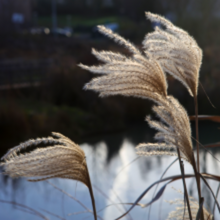Miscanthus sinensis, commonly known as Chinese silver grass, is a tall, ornamental grass valued for its graceful plumes and upright growth. This plant features narrow, arching leaves with a white midrib and produces feathery plumes, typically in shades of silver, pink, or bronze, from late summer into autumn. Its tall stature and elegant plumes make it a striking addition to gardens, borders, and naturalized settings, adding vertical interest and movement to various landscapes. It belongs to the Poaceae family.
Origin: Miscanthus sinensis is native to East Asia, including China, Japan, and Korea.
Light: Miscanthus sinensis thrives in full sun. It requires at least six hours of direct sunlight daily for optimal growth and plume production.
Water: Water regularly during the first growing season to establish a strong root system. Once established, it demonstrates some tolerance to drier conditions.
Soil: Miscanthus sinensis prefers well-drained soil. It can adapt to a range of soil types, but does best in fertile, loamy soil. Avoid heavy clay soils, which can retain excessive moisture.
Fertilising: A light application of balanced fertiliser in spring can support healthy growth. Avoid over-fertilizing, which can lead to excessive leaf growth at the expense of plumes.
Pruning: Cut back the foliage in late winter or early spring before new growth begins.
Clumping: Miscanthus sinensis forms clumps and generally does not spread aggressively, though some varieties may spread more than others.
Pests and Diseases: Miscanthus sinensis is generally resistant to pests and diseases.
Uses: Miscanthus sinensis is primarily grown as an ornamental grass for its attractive foliage and plumes. It's a popular choice for gardens, borders, and naturalized settings.
Toxicity: Miscanthus sinensis is generally considered safe for humans and pets.



